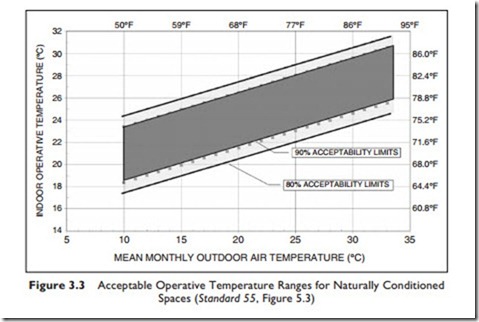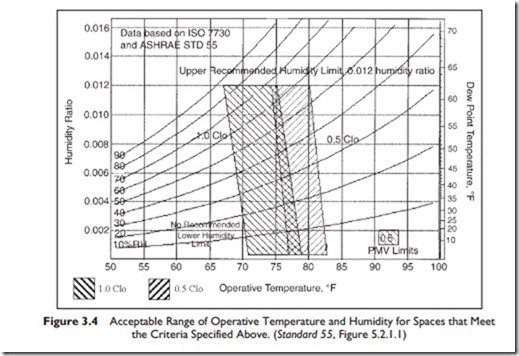Conditions for Comfort
Standard 55 deals with indoor thermal comfort in normal living environments and office-type environments. It does not deal with occupancy periods of less than 15 minutes.
The Standard recognizes that individual perceptions of comfort can be significantly modified by prior exposure. For example, consider people coming into a building that is air-conditioned to 82°F on a very hot day, when it is 102°F outside. The building is obviously cooler as they enter it, a pleasant experience. After they have been in the building for half an hour, they will have adjusted and will probably consider the building excessively warm.
When considering issues of comfort, the Standard addresses two situations:
1. Buildings with occupant-operable windows
2. Buildings with mechanically conditioned spaces
Situation 1: Buildings with Occupant-Operable Windows
People behave differently when they have windows they can control. They have different, less demanding, expectations due to their knowledge of the external environment and their control over the windows. They will also choose how they dress, knowing that the building temperatures will be significantly influenced by external temperatures.
Figure 3.3, shows the acceptable range of “indoor operative temperatures” plotted against “mean monthly air temperature” for Activity levels of 1.0 to 1.3 met Person not in direct sunlight Air velocity below 40 fpm No specific clothing ensemble values
This acceptable range is called the comfort envelope.
The indoor operative temperature is the average of the air temperature and radiant temperature.
The mean monthly outdoor temperature is the average of the hourly temperatures; data is normally available from government environmental- monitoring departments.
The chart only goes down to a mean monthly temperature of 50°F, indicating that operant-controlled windows (opening windows) do not provide acceptable thermal comfort conditions in cooler climates during the winter.
The plot shows the range of comfortable operative temperatures for 80% acceptability, the normal situation, and a narrower comfort band that will provide a higher standard of comfort, 90% acceptability. For example, for a location with a maximum summer mean-monthly temperature of 68°F, the range for 80% acceptability is between 71°F and 80°F.
Note that the normal situation suggests that 20% of the occupants, or 1 in 5, will not find the thermal conditions acceptable!
Situation 2: Buildings with Mechanically Conditioned Spaces Mechanically conditioned spaces are arranged into three classes:
Class A – high comfort Class
B – normal comfort
Class C – relaxed standard of comfort
Standard 55 includes comfort charts for Class B spaces only. To calculate comfort conditions for Classes A and C, the designer uses a BASIC computer program. The BASIC program listing is included in Standard 55, Appendix D.
The Class B thermal limits are based on 80% acceptability, leaving about 10% of the occupants not comfortable due to the overall thermal conditions and 10% not comfortable due to local thermal discomfort.
Class B Comfort Criteria
The Standard provides a psychrometric chart, Figure 3.4, showing acceptable conditions for a Class B space for:
Activity between 1.0 and 1.3 met
Clothing 0.5 to 1.0 clo
The air speed is to be below 40 fpm
The person must not be in direct sunlight
For spaces where it is reasonable to assume that clothing will be around 0.5 clo in the summer, and a design humidity of between 40 and 50%, the acceptable conditions, the comfort envelope, will be within the heavy lines on the chart.
Remember that the chart is for 80% acceptability, although ideally 100% of the occupants would find the conditions thermally acceptable. The occupants do have some limited flexibility with clothing in most situations. The ideal situation, but prohibitively expensive in most cases, is to provide all the occupants with their own temperature control.
Example 1: Let us suppose we wish to minimize the size of the air-conditioning plant; then we could choose design conditions of 81°F at 50% relative humidity, rh and 82°F at 40% rh. It must be recognized that when the designer designs on the limit, it means that more people are likely to be uncomfortable than if the designer chooses to design for the center of the comfort temperature band.
Figure 3.4 Acceptable Range of Operative Temperature and Humidity for Spaces that Meet the Criteria Specified Above. (Standard 55, Figure 5.2.1.1)
Example 2: Let us consider a different situation, a prestige office building with, at the design stage, unknown tenants. Here we should allow for both light dress and full suits, the full range 0.5 to 1.0 clo. If the design relative- humidity is to be 50%, then we should select the area of overlap and choose 76°F as our design temperature.
Example 3: As a third example let us consider a desert town with an outside design-condition of 90°F and 13% relative humidity. If we pass the incoming air over a suitably sized evaporative cooler, the air will be cooled and humidified to 78°F and 50% which is nicely within the comfort zone for people with 0.5 clo. In this case, we can achieve acceptable thermal comfort for supply ventilation using an evaporative cooler.

